Over 90 percent of flowering plants on our planet require pollination, and that’s where bees come in. Without a bee’s super pollination power, the food available for people and wildlife would be devastated. Additionally, many sources of shelter for wildlife would disappear. We’re lucky to have so many types of bees in Ohio, aiding our agriculture. Let’s explore some of the bees in the Buckeye state.
Honey Bee

Queen bees can lay over 3,000 eggs in a single day.
©iStock.com/Inventori
Honey bees are 12-15 millimeters long and have light to deep brown bodies. The alternating pale and dark stripes along the abdomen are most noticeable on a honey bee. A honey bee’s abdomen is round and barrel-shaped, and its fuzzy head forms the shape of a heart.
Honeybees also sport pollen baskets. Pollen baskets are flat areas on the back leg of a bee that have stiff hairs for collecting pollen. The pollen is then carried back to the hive for food.
Honey bees nest in man-made hives or in sheltered cavities like inside trees, old walls, or rock crevices. When a current colony is overpopulated, honey bees split their colony in what is called “swarming.” In preparation, the queen lays several new queen eggs in constructed swarm cells. Next, the queen leaves the hive, followed by half the workers in this tight, buzzing swarm. The group will settle on a nearby tree branch while scouts explore for a suitable home. Once a suitable home is found, the queen emits pheromones to have the group follow her to their new hive location.
The honey bee is one of the most prominent pollinators of all types of bees in Ohio. It is among the most important bees for Ohio’s agriculture, food diversity, and beautiful garden areas.
Leafcutting Bee
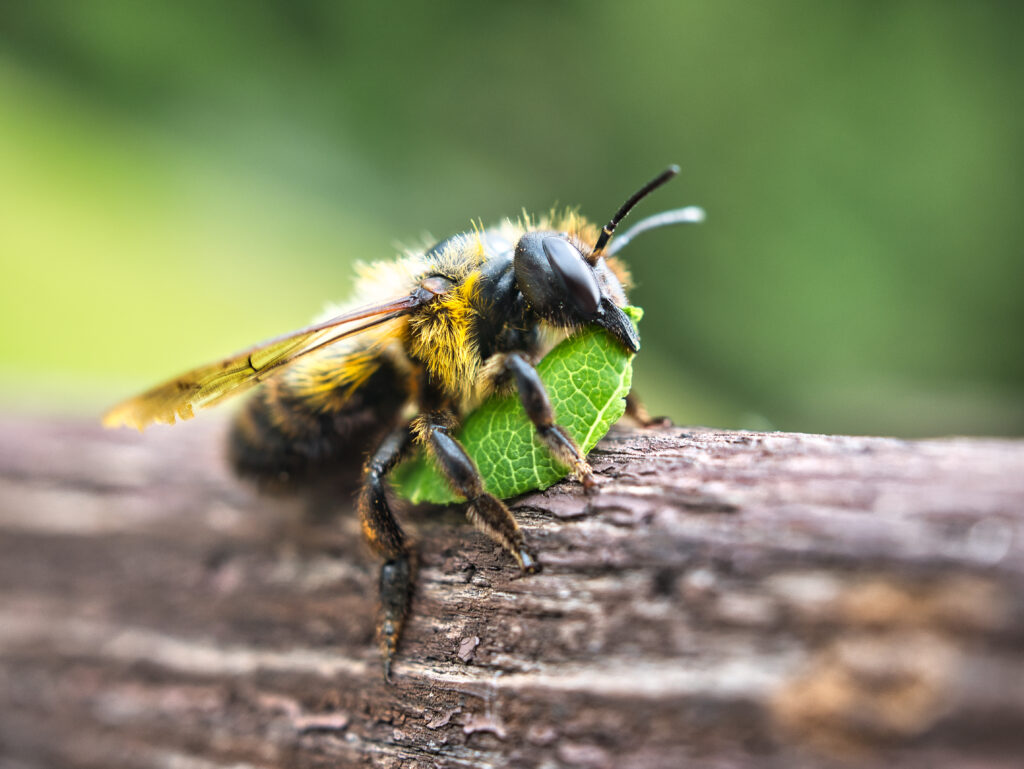
Leafcutter bees do not make honey.
©Maurice Lesca/Shutterstock.com
Ranging from 7-15 millimeters in size, these bees are smaller on average than the honey bee. Watch for a bee with a black body covered in light or dark hair to identify a leafcutter. It has a thick head as wide as its thorax and massive mouthparts used to cut leaves. Finally, a leafcutter bee’s abdomen is much pointer than a honey bee’s. Also, instead of pollen baskets, a leafcutter’s body features stiff hairs beneath the abdomen for pollen collection.
Leafcutter bees are solitary bees and don’t live in colonies. Female leafcutters do all the nest-building and rearing of their young. Preferring soft shelters that they can hollow out, female leafcutters often make their nests in rotting logs, plants with hollow stems, or in the ground. Because leafcutter bees are solitary in Ohio, you don’t have to worry about swarming. They primarily nest close to flower gardens or any accessible source of food.
Bumble Bee

Bees help us grow healthy food, help plants thrive to keep the air pure and clean, and make honey.
©Gerrit Lammers/Shutterstock.com
A bumble bee is on the larger end of bees, growing 8-21 millimeters in size. They have the iconic black body with bright yellow fuzz on all segments. Also, they have thick, round bodies with long faces. Another great identifier of the bumble bee: they have robust pollen baskets on their hind legs. These insects are also sneaky pollinators—preferring to travel from flower to flower when it is rainy or cool and cloudy. Most other types of bees in Ohio avoid this weather, so if you see a bee zipping around your flower garden in the rain, it is most likely the bumble bee.
Bumble bees are social insects and nest in colonies underground, often taking over empty rodent burrows. They will also occupy cavities in rock landscaping piles or in pockets of dense vegetation. Because swarming is triggered by overpopulation, bumble bee colonies don’t swarm. Their colony is only a few hundred bees at most, so there is never a need to split the colony. However, male bumble bees will hover and “dance” outside of a bumble bee nest to mate with the queen. After mating, the male bumble bee dies, and the queen bulks up on food in preparation for the winter. Only the queen hibernates throughout the winter; the rest of the colony dies. In the spring, the queen lays eggs for a new colony.
Sweat Bee

The metallic green sweat bee is attracted to human sweat for its salt content.
©Barbara Storms/Shutterstock.com
About 3.5-11 millimeters in size, this bee comes in two colors: vibrant, metallic green, or black/brown with light stripes along the abdomen. The sweat bee has a slight body with pollen-carrying hairs on its back legs. These are the only types of bees in Ohio attracted to your sweat. Although they feed on pollen and nectar, sweat bees supplement their diet with the salt from your sweat!
Up to 30 female sweat bees nest together, sharing a main burrow in the ground that can be 42 inches deep! From the main tunnel, individual females branch off to create cells for their eggs. After supplying each cell with pollen and nectar, the female deposits an egg in each cell and then closes up her tunnel with soil. Only females survive over the winter in established nests, which means overlapping generations may live together in one colony. Sweat bees, however, do not swarm.
Mason Bee
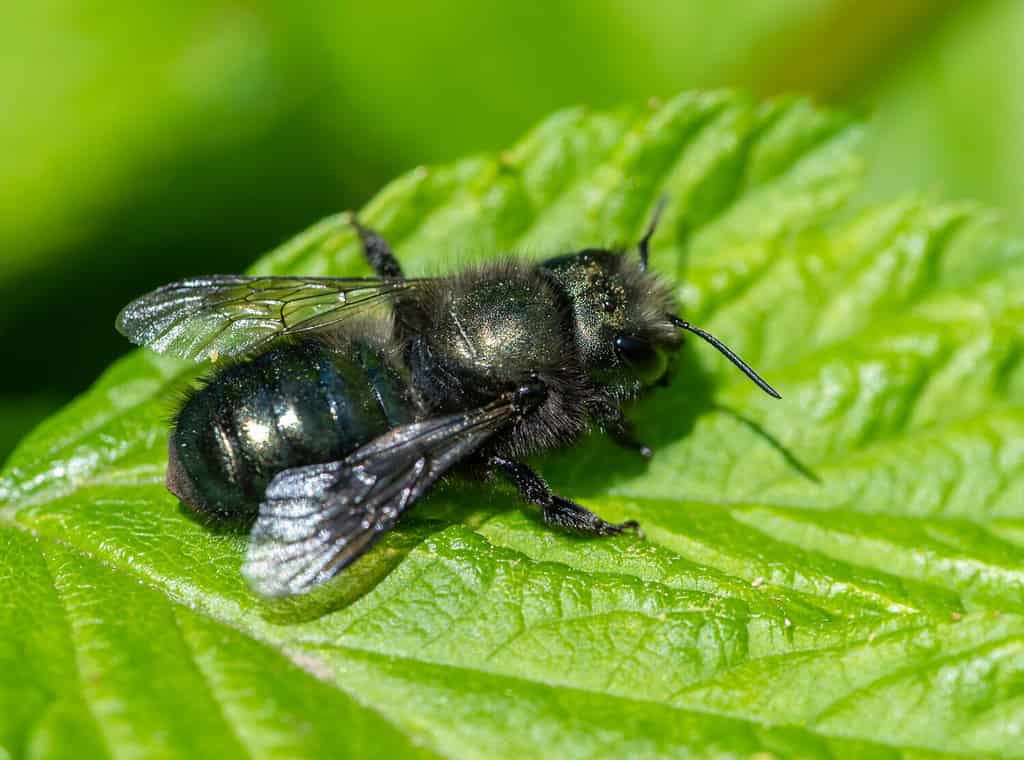
Female mason bees will collect mud to line their nest.
©Jennifer Bosvert/Shutterstock.com
Mason bees grow to be 7-16 millimeters in length. They come in two forms: a black body covered in pale hair or a washed-out metallic blue/green body with moderate hair. Mason bees don’t have a pollen basket; the stiff hairs beneath their abdomen collect pollen. Its head is as broad as its thorax and has a sturdy, round body.
The females solely nest in tree hollows, softening branches, or other wood cavities. They collect mud to line their nests and use a mix of mud and chewed leaves to fashion the egg cells. The female mason bees provide a pollen ball for the hatched larva in each cell. Because mason bees are solitary, they do not swarm.
Squash Bee
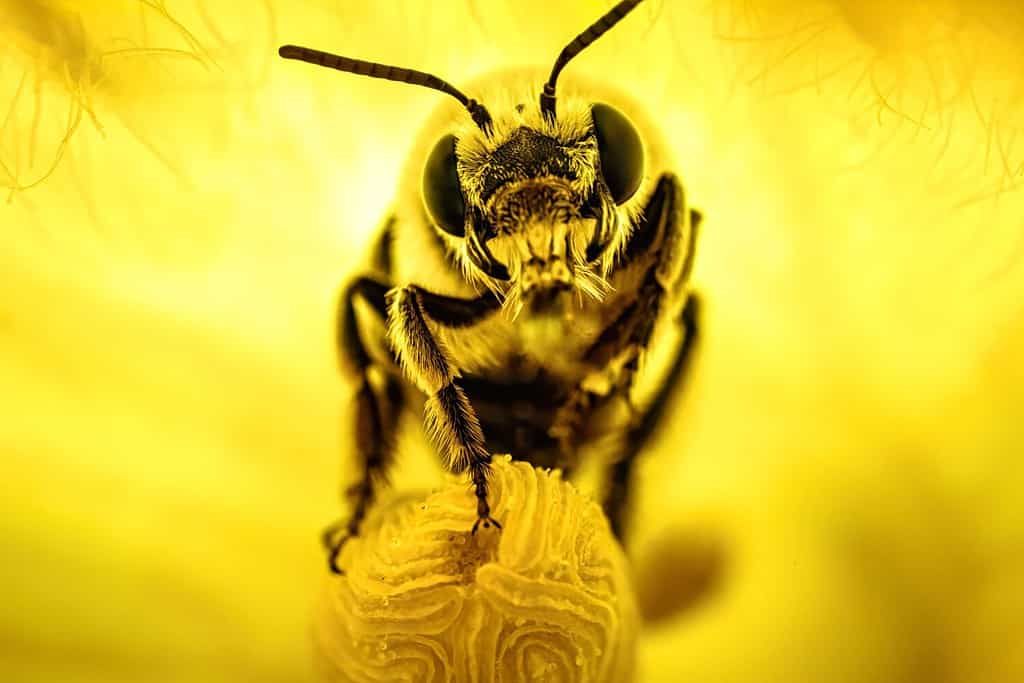
The squash bee features a longer antenna than other Ohio bees.
©Joseph Burdick/Shutterstock.com
The squash bee ranges from 11-14 millimeters in size, with a brown body covered in thick, yellow hair. The light and dark bands on the abdomen of this bee are quite distinct. And the squash bee has longer antennas than most types of bees in Ohio. It collects pollen on its hind legs as it buzzes around cross-pollinating.
The squash bee likes to settle by pumpkin and squash patches (thus the name). The females are solitary, ground-nesting insects. The female squash bee will excavate smaller branches off the main tunnel by digging a vertical burrow almost two feet straight down. These smaller branches morph into cells where the female will lay her eggs.
Even though squash bees are solitary nesting insects, the females will have burrows close to each other. But, these bees also do not swarm like the honey bee.
Small Carpenter Bee
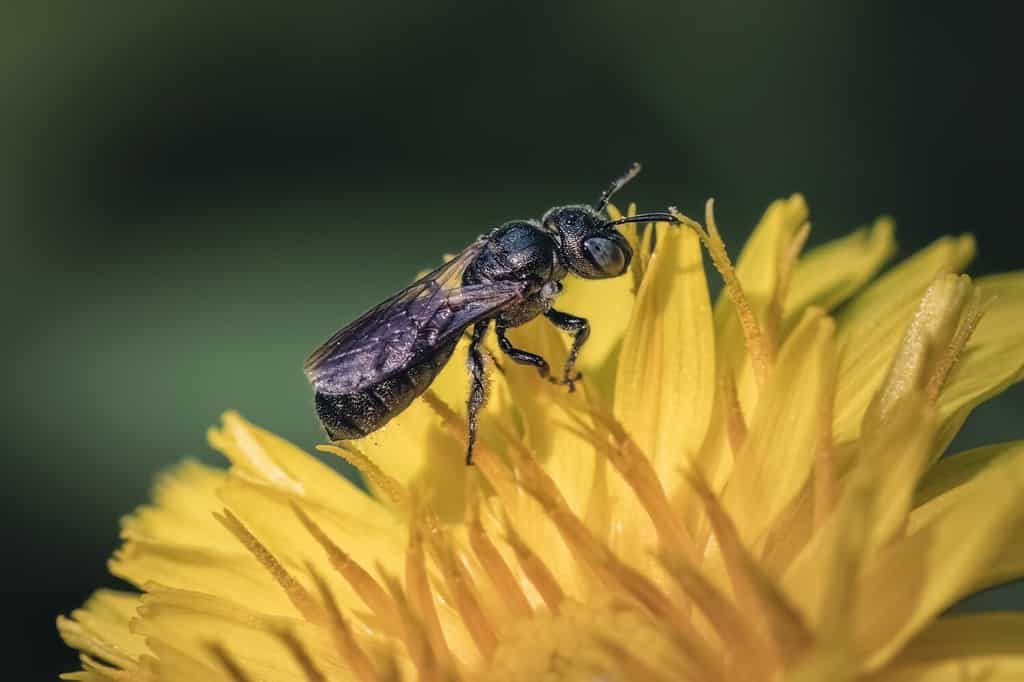
Carrying pollen on their back legs, these bees favor gardens, fields, and the outskirts of forests.
©Victoria Virgona/Shutterstock.com
A gorgeous green-blue insect, the small carpenter bee is nearly hairless. It has a slight sheen in the sunlight, and its abdomen is round, club shape. Carrying pollen on their back legs, these bees favor gardens, fields, and the outskirts of forests.
Also solitary bees, the females prefer to nest in the hollow of stems and twigs. Only 5-8 millimeters in size, the small carpenter bee lives up to its name! A female will bore into a stem in the fall and wait for winter. In the spring, the female will dig out the rest of the channel, about 15-18 centimeters in length, to craft cells for her eggs. After sealing the cells, the female small carpenter bee will then occupy the last chamber to guard her young against parasites.
Mining Bee

The mining bee is a solitary bee and likes to nest alone.
©Gabi Wolf/Shutterstock.com
With a black-colored body covered in dark or pale hairs, the mining bee ranges from 5.5 to 15 millimeters in length. Unlike most other types of bees in Ohio, the mining bee carries pollen on its back legs and its thorax. This can make it look like the mining bee is carrying clumps of pollen in its “armpits.”
Like many bee types, the mining bee prefers to nest alone, seeking out sandy landscapes for its ground nest. Though solitary, if there’s a choice nesting site, females will often tunnel in close proximity to each other. Their ground nests are small, with an entrance no bigger than the size of a number two pencil. The main tunnel goes down vertically only a few inches and splits into smaller chamber branches. The female mining bee waterproofs each chamber with a waxy substance produced by her abdomen.
Each cell is outfitted with a ball of pollen/nectar mix for the hatched larva to feed on. These infant mining bees will go through the winter in the pupa stage, emerging from their chambers in the spring as full adults.
Longhorn Bee
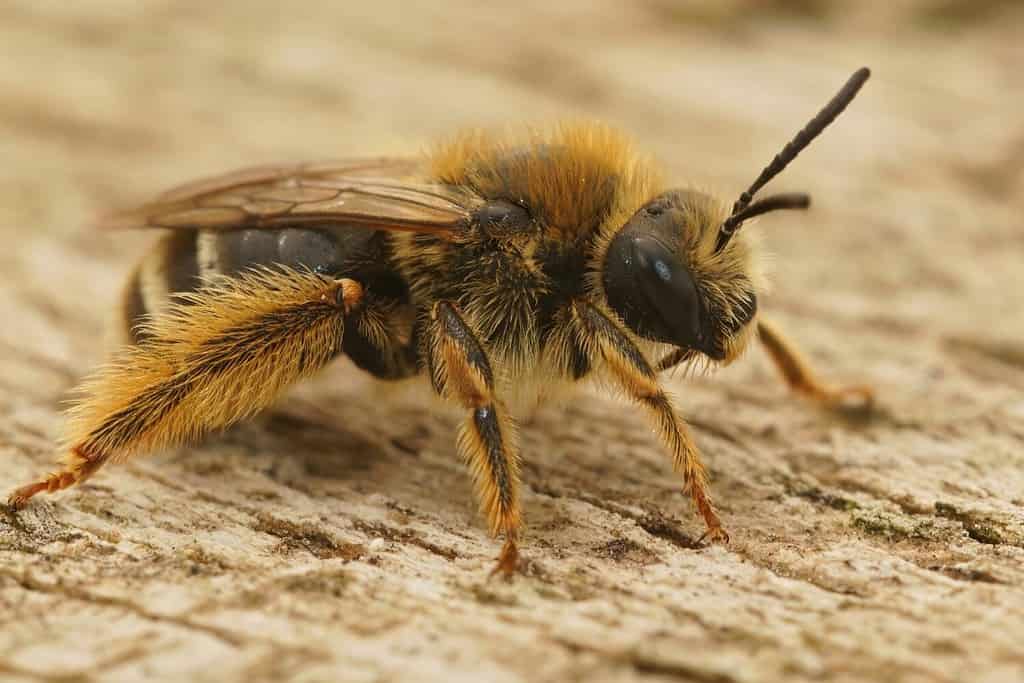
The longhorn bee doesn’t swarm to make a new colony, as they are lone, ground-nesting bees.
©HWall/Shutterstock.com
This bee commands a deep black body engrossed in fuzzy pale or dark hairs. While this bee carries pollen on its back legs, those legs are longer than the average bee. The males have lengthy antennas, which is why this bee is named “longhorn.” They range from 8-16 millimeters in size.
The longhorn bee doesn’t swarm to make a new colony, as they are lone, ground-nesting bees. They typically like to construct a burrow in a shady area under shrubbery. The longhorn females spend the majority of their life span digging the branching egg chambers, so if you discover a longhorn nest, it is considerate to leave it be. Collapsing the tunnels is devastating to the reproductive timeline of the longhorn.
Each egg chamber amasses a ball of pollen which feeds the larva as it develops until the next season. Males surface around mid-May, with female longhorns appearing a few weeks later. These bees are active until August, when the egg-laying cycle begins again.
Summary of Types of Bees in Ohio
While Ohio has an impressive diversity of bees, you will only see the honey bee swarming. Most bee species are solitary nesting insects, preferring ground tunnels to nest in trees. But all of these bees, whether they have pollen baskets or an abdomen that amasses pollen, are fantastic pollinators of Ohio.
Because of these dutiful insects, Ohio has booming fruit and vegetable crops. These bees especially contribute to the prolific apple, melon, cucumber, and pumpkin harvests. Also, according to the Ohio Department of Agriculture, in 2021, Ohio produced over one million pounds of honey. Honey is in high demand, with almost 618 pounds sold in 2021. It’s a very stable and profitable food to have.
That is why all types of bees in Ohio need to be protected. Being cognizant of destructive pesticides and keeping abundant pollination spaces for these bees is crucial for their survival. Bees do so much good for Ohio that they deserve all the sanctuaries we can give them.
The photo featured at the top of this post is © HWall/Shutterstock.com
Thank you for reading! Have some feedback for us? Contact the AZ Animals editorial team.






